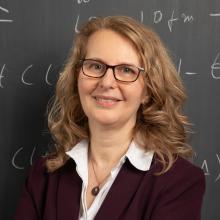
The dance of the muon
Aida El-Khadra, Dept. of Physics, University of Illinois, Urbana-Champaign
Abstract: More than eighty years after the muon was discovered it is still a source of mystery. I ndeed, experiments are underway that use muons as a window to search for new particles or forces. The muon's anomalous magnetic moment is a particular focus of these efforts because of a longstanding tension between experiment and theoretical expectations. This quantity is now known with an exquisite precision of 190 parts per billion, thanks to the g-2 experiment at Fermilab, which is on track to reach its precision goal of 120 part per billion in the next couple of years. The theoretical calculations of the muon’s magnetic moment must account for the virtual effects of all particles and forces within the Standard Model, where effects coming from virtual hadrons, governed by the strong interactions, are by far the largest sources of theory uncertainty. Recent estimates of hadronic corrections have created puzzles on the theory side, which are currently being investigated. I will discuss the ongoing interplay between theory and experiment that is essential to unlocking the discovery potential of this effort.
About Aida El-Khadra

Aida El-Khadra is a Professor of Physics at the University of Illinois, Urbana-Champaign. Her research interests are in theoretical particle physics, with a focus on the development of lattice field theory as a precision tool to quantify the nonperturbative effects of Quantum Chromodynamics needed for the interpretation of measurements in high energy experiments. She is a fellow of the AAAS and APS, as well as a recipient of a Simons Fellowship in Theoretical Physics, a Fermilab Distinguished Scholar appointment, a Sloan Foundation Research Fellowship, and a Department of Energy Outstanding Junior Investigator Award. She currently serves as chair of the Steering Committee of the Muon g-2 Theory Initiative, which was created in response to the experimental efforts at Fermilab and JPARC.
Audience:

